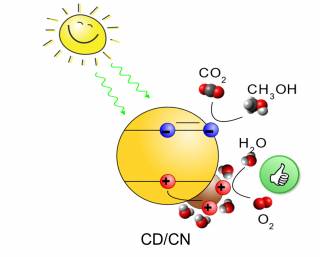The conversion of carbon dioxide to high-value chemicals not only provides a renewable energy source, but also mitigates climate change due to anthropogenic CO2 emission. Nature employs very efficient strategies to convert CO2 to biomass by utilizing catalysts composed of abundant and low-cost elements such as C, N and so on. To avoid additional CO2 generation, it is highly desirable to drive CO2 reduction by renewable and low-carbon energy sources, such as solar energy and low-cost catalysts. Using our exquisitely designed carbon-dots/carbon-nitride (CD/CN) junction, we show stable conversion of water and CO2 to stoichiometric O2 and methanol with nearly 100% selectivity under sunlight. The key behind these new exciting results is the unique hole-accepting nature of the novel CD and its selective adsorption of water over methanol.

Two photoreactions are driven by the system: 1) water (H2O) oxidation and 2) CO2 reduction to high-value products, in this case, methanol (CH3OH). High-performance photocatalysts utilize co-catalysts to enhance the catalytic properties of the surface and accelerate the rate of reaction. The heterojunction between the light-absorbing photocatalyst and the co-catalyst also makes electrons and holes flow to different materials and limit how fast they find each other (leading to the annihilation reaction termed recombination). This translates to an increase in a lifetime and a greater chance they do the desired reaction.
There is seemingly a tendency to focus on the reduction reaction co-catalyst as this produces the high-value product (think methanol from CO2 or H2 gas from protons). However, the water oxidation reaction is usually the slowest step and will limit the efficiency of the whole system. The development of water oxidation co-catalysts that can extract holes from the photocatalyst and promote reactivity is a more direct path to an improved system.
This is exactly what we found for our carbon dots fabricated via a microwave-assisted method. The time-resolved spectroscopic investigations prove that our carbon dots serve as a notable hole acceptor in CD/CN. Charge separation across the CD/CN interface increases by 4 times, and the long lifetime of photoelectrons in CD/CN converts CO2 selectively to methanol with unprecedented selectivity of 99.6±0.2 %. Furthermore, computational results showed that water prefers adsorption to CD (where holes accumulate) while methanol prefers adsorption to CN (where electrons accumulate), thus facilitating selective oxidation of water to O2 while avoiding unproductive oxidation of the photoreduction product, methanol.
The production of methanol proceeds with an exceptional near unity selectivity in our lab. This strategy selectively reduces greenhouse gas by water to high-value chemicals, hence offering sustainable liquid fuels and closing the global carbon cycle.
Selected Publications
Wang, Y., Liu, X., Han, X., Godin, R., Chen, J., Zhou, W., ...Shevlin, S.A. (2020). Unique hole-accepting carbon-dots promoting selective carbon dioxide reduction nearly 100% to methanol by pure water.. Nat Commun, 11 (1), 2531. doi:10.1038/s41467-020-16227-3
 Close
Close

